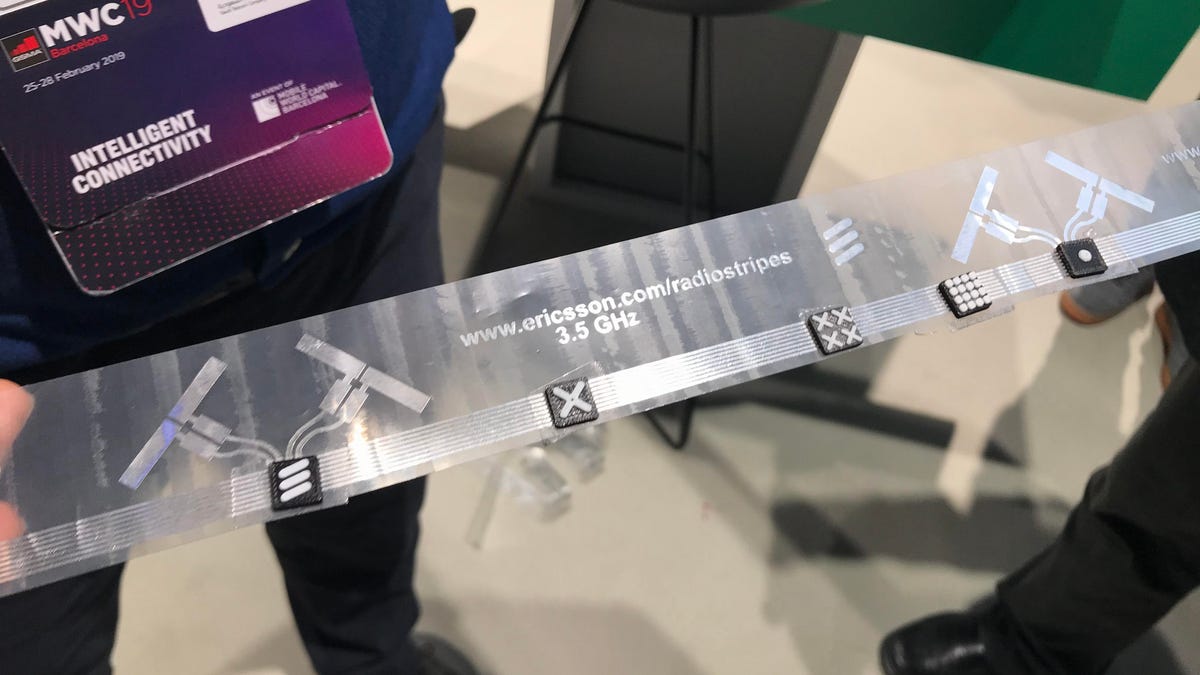The biggest 5G breakthrough may be this harmless, little plastic strip
Ericsson is working on an antenna that could be placed under carpets or hung on walls. Think coverage everywhere.

This plastic strip holds little plastic circuit boards and antennas for 5G signals.
5G is going to change your life. But first, it actually needs to get to you.
Though 5G networks are starting to go live, the deployments remain limited. That's because many of the carriers, including Verizon and AT&T , are employing super high-frequency airwaves through something called millimeter wave spectrum, which offers a fat data pipe for insane speeds but has limited range. Another of its big issues is an inability to get through walls -- even a leaf could theoretically disrupt the service.
Enter a seemingly innocuous strip of plastic found in the Mobile World Congress booth of Ericsson , the Swedish supplier of telecom equipment. The strip contains printed circuit boards and tiny antennas able to pick up and send 5G data. Along the walls at one of Ericsson's demos, the strip was embedded behind a thin piece of wallpaper or hidden by a thin plastic housing. Another strip was laid under a long train of carpet that was rolled up.
"This is how easy your network rollout will be," Pal Frenger, a researcher at Ericsson, said as he placed the roll on the floor and kicked it open. He liked the joke so much, I heard him say it again a few minutes later.
This little strip could have big implications for how 5G might get deployed. Carriers are still struggling with how to deal with the limitations of millimeter wave spectrum, which is why many are opting to use lower-frequency (slower, but broader) spectrum. The huge number of small cells -- miniature cellular towers -- required to create a network is another obstacle, since many cities don't want that many eyesores in their communities.
Here's your network rollout. Har har.
AT&T Chief Technology Officer Andre Fuetsch, in an interview with CNET at MWC, referred to its 5G deployments as "small pockets."
But the ease with which you could hang up (or roll out) these strips, or even temporarily install them at an outdoor venue, could turbocharge the deployment of 5G by offering better coverage in little corners. By offering a simpler, easier method for stringing up antennas that are compatible with millimeter wave spectrum or even mid-band frequencies, the strip could let users get the maximum benefit of 5G.
More from MWC 2019
Still just a prototype
The technology sounds amazing, but it's likely several years away from becoming reality. The prototype is the work of an arm of Ericsson's research and development team that was tasked with figuring out innovative approaches to networking technology. It doesn't work yet, and those little antennas on the strip are fake. The 3.5Ghz spectrum printed on the strip don't necessarily mean they're actually able to pick up on those signals yet.
A spokesman said the team likely hasn't looked into things like the safety implications of having these signals broadcast anywhere. At this point, it's just figuring out if Ericsson could actually do it.
The strip can theoretically be embedded under a carpet.
But the strip had telecom executives looking with intense interest. I saw China Mobile executives gawk at the technology.
Cue the Ericsson representative.
"This is how easy your network rollout will be..."
The story originally published at 6 a.m. PT on March 1.

